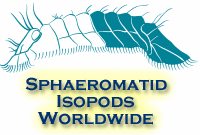| Abstract |
wo new species of Ischnomesidae, Haplomesus celticensis sp. nov. and Haplomesus hanseni sp.nov. are described from the southwest of Ireland and the Argentine Basin respectively. Both specieslack the expression of pereopod VII, a characteristic that we argue is produced by progenesis, notneoteny as suggested by Brökeland & Brandt (2004). Haplomesus angustus Hansen, 1916 andHaplomesus tropicalis Menzies, 1962, also lack pereopod VII and are revised from the typematerial. The original description of Haplomesus angustus Hansen, 1916 describes the adult typespecimen as a juvenile; the original description of Haplomesus tropicalis Menzies, 1962 fails tomention the lack of pereopod VII. Progenesis is discussed for the above species and within thefamily Ischnomesidae as a whole.Key words: Isopoda, Asellota, Ischnomesidae, Haplomesus, heterochrony, progenesisIntroductionThe Ischnomesidae is a family of marine benthic asellote isopods found mostly at bathyaland abyssal depths, with records from about 250–7000 m (Wolff 1962; Kussakin 1988). Todate, 99 species have been described in five genera. The known diversity of this family,however, is increasing owing to recent reports of several new species (e.g. Merrin & Poore2003). In this paper, we report two new species of Haplomesus from the Atlantic Ocean,Haplomesus celticensis sp. nov. from the Celtic Sea off southwestern Ireland, andHaplomesus hanseni sp. nov. from the Argentine Basin. These species are unusual becausethey lack pereopod VII. Two other ischnomesid species with the same condition have beendescribed recently by Brökeland & Brandt (2004): Haplomesus corniculatus and |

















